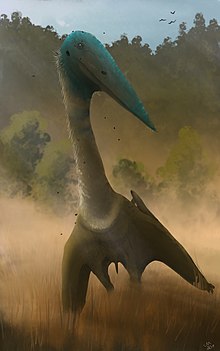Volgadraco ("Volga River dragon") is a genus of pteranodontian pterosaur from the Upper Cretaceous of European Russia.
| Volgadraco Temporal range: Late Cretaceous,
| |
|---|---|

| |
| Speculative reconstruction of Volgadraco as an azhdarchid | |
| Scientific classification | |
| Domain: | Eukaryota |
| Kingdom: | Animalia |
| Phylum: | Chordata |
| Order: | †Pterosauria |
| Suborder: | †Pterodactyloidea |
| Clade: | †Pteranodontia |
| Genus: | †Volgadraco Averianov et al., 2008[1] |
| Species: | †V. bogolubovi
|
| Binomial name | |
| †Volgadraco bogolubovi Averianov et al., 2008[1]
| |
Discovery and naming
editVolgadraco is known from lower beak (holotype SGU, no. 46/104a) and postcranial fragments from the early Campanian-age Rybushka Formation of Saratov, Russia. The size of this animal, and the development of blood supply in the lower jaw are intermediate between older Santonian or Turonian azhdarchids like Azhdarcho and Bakonydraco and later Maastrichtian azhdarchids like Quetzalcoatlus. Volgadraco was described in 2008 by Averianov, Arkhangelsky, and Pervushov. The type species is V. bogolubovi, the specific name honouring Russian paleontologist Nikolai Nikolaevich Bogolubov.[1]
Classification
editAverianov and colleagues initially assigned Volgadraco to the family Azhdarchidae, and considered the earlier named genus Bogolubovia to be a nomen dubium that is potentially identical to Volgadraco.[1] In contrast, Longrich and colleagues in 2018 had recovered it within the family Nyctosauridae, the cladogram of which can be seen below:[2]
In 2020, Averianov and Arkhangelsky reconsidered both Bogolubovia and Volgadraco as members of the family Pteranodontidae.[3] In 2022, Averianov and Kurin considered both Volgadraco and Bogolubovia as valid pteranodontids based on a new specimen of Bogolubovia.[4] In the same year, however, Volgadraco was considered to be a pteranodontian both outside the Nyctosauridae and Pteranodontidae based on phylogenetic analysis, the cladogram of which can be seen below:[5]
| Pteranodontia |
| |||||||||||||||||||||||||||||||||||||||||||||||||||||||||||||||
See also
editReferences
edit- ^ a b c d Averianov, A.O.; Arkhangelsky, M.S.; Pervushov, E.M. (October 2008). "A New Late Cretaceous Azhdarchid (Pterosauria, Azhdarchidae) from the Volga Region". Paleontological Journal. 42 (6): 634–642. Bibcode:2008PalJ...42..634A. doi:10.1134/S0031030108060099. S2CID 129558986.
- ^ Longrich, Nicholas R.; Martill, David M.; Andres, Brian; Penny, David (2018). "Late Maastrichtian pterosaurs from North Africa and mass extinction of Pterosauria at the Cretaceous-Paleogene boundary". PLOS Biology. 16 (3): e2001663. doi:10.1371/journal.pbio.2001663. PMC 5849296. PMID 29534059.
- ^ Alexander O. Averianov; Maxim S. Arkhangelsky (2020). "A large pteranodontid pterosaur from the Late Cretaceous of Eastern Europe". Geological Magazine. 158 (7): 1143–1155. doi:10.1017/S0016756820001119. S2CID 229441587.
- ^ Averianov AO, Kurin AS (2022). "A new specimen of pteranodontid pterosaur Bogolubovia orientalis from the Upper Cretaceous of Penza Province, Russia". Historical Biology: An International Journal of Paleobiology. 35 (8): 1288–1296. doi:10.1080/08912963.2022.2087522. S2CID 249728681.
- ^ Fernandes, Alexandra E.; Mateus, Octávio; Andres, Brian; Polcyn, Michael J.; Schulp, Anne S.; Gonçalves, António Olímpio; Jacobs, Louis L. (2022). "Pterosaurs from the Late Cretaceous of Angola". Diversity. 14 (9). 741. doi:10.3390/d14090741. hdl:10362/145845.